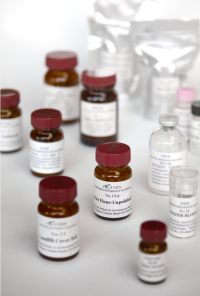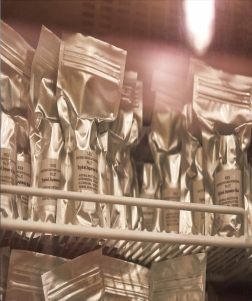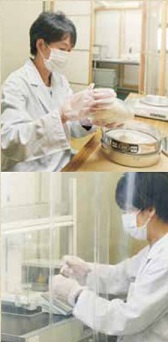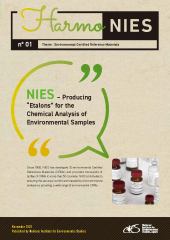HarmoNIES No.1
Environmental Certified Reference Materials
NIES - Producing "Etalons" for the Chemical Analysis of Environmental Samples
"The NIES CRM program will continue to support the accuracy of environmental analysis by providing a wide range of environmental CRMs. "
Definition of RMs and CRMs
Reference Materials (RMs) are materials, sufficiently homogeneous and stable with respect to one or more specified properties, which has been established to be fit for its intended use in a measurement process. Certified Reference Materials (CRMs) are Reference Material which is characterized by a metrologically valid procedure for those specified properties, accompanied by a certificate that provides the value of the specified property, its associated uncertainty, and a statement of metrological traceability (ISO Guide 30:2015).
*ISO Guide 30:2015. Reference materials— Selected terms and definitions
(https://www.iso.org/standard/46209.html)
What if Measurement Scales Differed Depending on the Person?
In the same way, what if we want to measure the chemical characteristics of substances, such as the concentrations of elements? How can we prove the accuracy of the measured data? To ensure the scientific correctness of data, researchers have been using materials called Reference Materials (RMs) and Certified Reference Materials (CRMs) which NIES developed to use as measurement standards.
Seven Team Members Producing Environmental CRMs
The environmental CRMs are produced by various research institutes around the world including NIES. All institutes pursue to improve the accuracy of chemical analysis of environmental samples but the largest difference between NIES and others might be the size of the team – the NIES CRM program comprises only seven members.
The program runs with a small number of staff paying close attention to the CRMs’ entire production processes from material selection and sampling; material processing (i.e., drying, powdering, sieving, blending, bottling, statistical progressing); and ending with certification in accordance with ISO 17034 (see column). No wonder it takes at least three years to complete this entire process! The CRMs program also takes advantage of obtaining valuable information from experts inside and outside NIES to produce variety of environmental CRMs — NIES has many experts from various disciplines in the field of environmental research.
Characteristics of NIES CRMs – Pursuing Nearly Natural CRMs
On the contrast to highly-pure reagent containing specific elements and compounds, environmental samples are often complicated mixtures of elements and compounds requiring appropriate measurement approaches depending on the analytical purposes. For example, hair contains both organic and inorganic mercury species that have become entrapped via different mechanisms. If concentrated chemical is added during the material processing of CRM production, it will not be entrapped to the CRM as in the nature, and the data obtained using the CRM may be incorrect even when measured in a defined approach. In this respect, it is important that CRMs are closer to natural substances and this is why NIES uses only natural substances to prepare CRMs that have been adapted for domestic and international environmental regulations.
All CRMs are prepared to meet the global standards (International Organization for Standardization, ISO) and are registered to the international reference materials database (COde d'indexation des MAtériaux de Référence, COMAR). The CRM program has such an uncompromising approach for producing CRMs ensuring the accuracy control and traceability of environmental analyses. The following paragraphs describes two of distinctive NIES CRMs, "Rice Flour-Unpolished" and "Typical Japanese Diet", and how they obtain nearly natural samples.
Rice Raised at NIES
The NIES CRM members used a tank-farming approach to raise, harvest, and thresh rice as their material in NIES’ premises. Cadmium chloride was added to the tank during the cultivation, allowing the roots to uptake and accumulate it into the rice grains. By this process, NIES CRM No.10-d Rice Flour-Unpolished contains cadmium at standard level.
Meals from Hokkaido to Okinawa:
NIES CRM No.27 Typical Japanese Diet is of great importance for research on chemical substances accumulated into human body from the diet. The dietary intake of contaminant elements, such as arsenic, cadmium, and lead, has been assessed in various research. Japan has a rich food culture that varies considerably by geographical area from the North to the South, from the coast and river to the mountainous inland. To produce the CRM, 29 households from 23 prefectures, from Hokkaido to Okinawa, were selected taking into consideration age and gender. Each household prepared meals in duplicate diet method over three days each in spring and autumn. The households prepared total of 522 meals weighing 60kg including miso soup, grilled fish, sushi, deep-fried pork, snacks, beverages and drinking water. These were all sent to NIES in frozen state to have them freeze-dryed to grind and homogenize, and then bottled.
Future Insights
Forty years have passed since the start of the CRM program, and their scientific challenge continues pursuing to improve the accuracy on chemical analysis of environmental samples and to develop new CRMs.
The demand for environmental CRMs diversifies as the environment and social conditions changes and as analytical technologies advances. The CRMs are also expected to have a greater variety and values, such as isotopic compositions. The NIES CRM program will continue to support the accuracy of environmental analysis by providing a wide range of environmental CRMs.
*Reference: Ministry of Health, Labour and Welfare (MHLW) (2010) Partial Revision of Specification and Standards for Food, Food Additives, etc. (Department of Food Safety, 0408 No.2) (in Japanese)
The Production Process of NIES’Environmental CRMs
1. Preparation of raw materials (collection, cultivation, etc.)
▼
2. Homogenization (drying, powdering, sieving, blending)
▼
3. Bottling
▼
4. Certification
▼ 1) Assessment of homogeneity
▼ 2) Assessment of stability and setting expiry date
▼ 3) Characterization by a network of independent laboratories
▼ 4) Determination of certified values and evaluation of uncertainties
5. Issuing of certificate and registration to COMAR and RMinfo
▼
LIST of NIES CRMs
| CRM No. | Name | Certified Value |
| No.3 | Chlorella | Elements |
| No.10-d | Rice Flour-Unpolished | Elements |
| No.12 | Marine Sediment | Organo Sn |
| No.13 | Human Hair | Methyl Hg |
| No.15 | Scallop | Organo Sn |
| No.18 | Human Urine | Organo As |
| No.23 | Tea Leaves II | Elements |
| No.24 | Fly Ash II | PCDDs, PCDFs |
| No.26 | Water Bloom | Microcystins, Elements |
| No.27 | Typical Japanese Diet | Elements |
| No.28 | Urban Aerosols | Elements |
| No.29 | Water Hyacinth | Elements |
| No.30 | Gobi Kosa Dust | Elements |
| No.31 | Lake Sediment | Elements |
| No.32 | Bluegill | PFOS |
| No.33 | Landfill Cover Soil | Elements |
Related Papers
- Yamakawa A., Takeuchi A., Shibata Y., Bérail S., Donard O. F. X. (2016) Determination of Hg isotopic compositions in certified reference material NIES No. 13 Human Hair by cold vapor generation multi-collector inductively coupled plasma mass spectrometry. Accreditation and Quality Assurance, 21, 197-202.
- Nishikawa M., Sano T., Nagano K., Ukachi M., Onishi K., Yamakawa A., Takeuchi A., Hirano M., Mori I. (2020) Development and characteristics of a new certified reference material for landfill cover soil analysis with extraction by dilute hydrochloric acid. Analytical Methods, 12, 1896-1905.
- Yamakawa A., Bérail S., Amouroux D., Tessier E., Barre J., Sano T., Nagano K., Kanwal S., Yoshinaga J., Donard O. F. X. (2020) Hg isotopic composition and total Hg mass fraction in NIES Certified Reference Material No. 28 Urban Aerosols. Analytical and Bioanalytical Chemistry, 412, 4483-4493.
Download PDF
Inquiry
International Coordination Office, Planning Division
National Institute for Environmental Studies
16-2 Onogawa, Tsukuba, Ibaraki 305-8506, Japan
e-mail: int-pub{a}nies.go.jp





